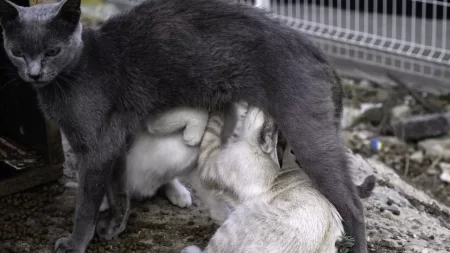If your cat is scratching, licking, or vomiting more than usual, they may have a food allergy or intolerance.
This means that their immune system reacts to certain ingredients in their diet, causing inflammation and discomfort.
Finding the right cat food for allergies and intolerances can help your cat feel better and prevent serious complications.
Understanding Allergies and Intolerances in Cats
Symptoms and Causes
Allergies and intolerances are different types of hypersensitivity reactions to foreign substances, called allergens.
Allergies involve an immune response that produces antibodies and histamine, while intolerances do not. However, both can cause similar symptoms in cats, such as:
- Itchy skin, ears, or paws.
- Hair loss or over-grooming.
- Redness, rash, or scabs on the skin.
- Vomiting or diarrhea.
- Flatulence or bloating.
- Sneezing, coughing, or wheezing.
- Runny nose or eyes.
The severity and frequency of symptoms may vary depending on the type and amount of allergen, the cat’s genetic predisposition, and environmental factors.
Some cats may have mild or occasional reactions, while others may have chronic or life-threatening ones.
Common Food Allergens and Intolerances
Cats can be allergic or intolerant to any food ingredient, but some are more common than others. According to PetMD, the most common food allergens for cats are:
- Beef
- Dairy products
- Fish
- Chicken
- Eggs
- Wheat
- Soy
Some cats may also be intolerant to food additives, preservatives, artificial colors, or flavors.
The only way to diagnose a food allergy or intolerance is to perform an elimination diet trial, which involves feeding the cat a novel or hydrolyzed protein diet for several weeks and then reintroducing potential allergens one by one.
This process should be done under veterinary supervision to ensure safety and accuracy.
Types of Allergy-Friendly Cat Food
There are several types of cat food that are designed to reduce or eliminate the risk of allergic reactions. These include:
1. Hypoallergenic Diets
These are diets that contain hydrolyzed proteins, which are broken down into smaller molecules that are less likely to trigger an immune response.
These diets are usually prescription-only and require veterinary approval.
2. Limited Ingredient Diets
These are diets that contain fewer ingredients than regular cat food, usually one protein source and one carbohydrate source.
These diets are meant to simplify the cat’s diet and avoid potential allergens. However, they are not guaranteed to be hypoallergenic, as some cats may still react to the ingredients.
3. Novel Protein Diets
These are diets that contain protein sources that are uncommon or new to the cat, such as rabbit, duck, venison, or kangaroo.
These diets are based on the assumption that the cat has not been exposed to these proteins before and therefore has not developed an allergy to them. However, some cats may still develop an allergy over time.
4. Grain-free Diets
These are diets that do not contain grains such as wheat, corn, rice, or oats. These diets are popular among some pet owners who believe that grains are harmful or unnatural for cats.
However, there is no scientific evidence that grains cause allergies in cats. In fact, some grain-free diets may contain other ingredients that are more likely to cause allergies, such as potatoes, peas, or lentils.
5. Prescription Diets
These are diets that are specially formulated by veterinarians to treat specific medical conditions in cats.
Some prescription diets may be hypoallergenic, limited ingredients, a novel protein, or be grain-free, depending on the cat’s needs. These diets require veterinary authorization and regular monitoring.
Choosing the Right Cat Food for Allergies and Intolerances
The best way to choose the right cat food for allergies and intolerances is to consult with your veterinarian. They can help you identify the possible causes of your cat’s symptoms, perform diagnostic tests if needed, and recommend a suitable diet trial. They can also advise you on how to transition your cat to a new diet safely and gradually.
1. Recommended low-glycemic single-ingredient diets
Some veterinarians may recommend feeding your cat a low-glycemic single-ingredient diet as part of an elimination diet trial or as a long-term solution for allergies and intolerances. A low-glycemic diet is one that does not cause a rapid rise in blood sugar levels after eating. A single-ingredient diet is one that contains only one type of food, usually meat. These diets may help reduce inflammation and improve digestion in cats with allergies and intolerances.
Some examples of low-glycemic single-ingredient diets for cats are:
- Raw meat (such as beef, chicken, turkey, lamb, and rabbit)
- Cooked meat (such as beef liver)
- Canned fish (such as tuna)
- Freeze-dried meat (such as chicken breast)
These diets should be fed in moderation and supplemented with other nutrients such as taurine, vitamins, minerals, and omega-3 fatty acids. You should also consult with your veterinarian before feeding these diets to your cat.
2. Hypoallergenic cat foods on the market
Hypoallergenic cat foods help prevent allergies in cats. They have one protein that is rare or hydrolyzed, so it is smaller and less likely to cause a reaction. They don’t have ingredients that can cause allergies, like corn, wheat, soy, and dairy.
3. Hill’s Prescription Diet z/d Skin/Food Sensitivities Cat Food
Hydrolyzed chicken is the only protein in this dry cat food. You need a prescription to buy it. It has omega-3s, antioxidants, and prebiotics for skin, immune, and digestive health. Cats with food problems can eat it.
4. Reveal Tuna Fillet in Natural Broth
This is a limited-ingredient wet cat food that contains tuna fillet as the only protein source. It also contains natural broth, sunflower oil, and vitamins. It does not contain any grains, soy, dairy, or artificial additives. It is suitable for cats with food allergies, intolerances, or sensitivities.
5. Royal Canin Cat Food for Skin Allergies
This dry cat food is available only by prescription and it exclusively consists of hydrolyzed soy protein as the protein source. Additionally, it includes omega-3 fatty acids, biotin, and vitamin A to promote healthy skin, coat, and barrier function. It is specifically designed for cats with food allergies, intolerances, or sensitivities. Cats find it highly palatable.
Conclusion
Allergies and intolerances are common conditions in cats, causing symptoms like itching, vomiting, or sneezing.
These conditions can be triggered by various allergens, including beef, dairy, or fish. To alleviate symptoms and prevent complications, it is important to find the appropriate cat food for allergies and intolerances.
Options include hypoallergenic diets, limited ingredient diets, novel protein diets, grain-free diets, or prescription diets. Consulting with your veterinarian is the optimal approach for selecting the right cat food.
Veterinarians can determine potential causes, conduct necessary tests, and recommend suitable diet trials.
Additionally, they can provide guidance on safely and gradually transitioning your cat to a new diet.







